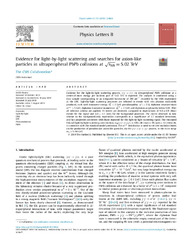Evidence for light-by-light scattering and searches for axion-like particles in ultraperipheral PbPb collisions at √sNN = 5.02 TeV
| dc.contributor.author | Sirunyan, A. M. | |
| dc.contributor.author | Işıldak, Bora | |
| dc.date.accessioned | 2020-06-29T08:43:00Z | |
| dc.date.available | 2020-06-29T08:43:00Z | |
| dc.date.issued | 2019-10-10 | |
| dc.identifier.issn | 0370-2693 | en_US |
| dc.identifier.uri | http://hdl.handle.net/10679/6656 | |
| dc.identifier.uri | https://www.sciencedirect.com/science/article/pii/S0370269319305404 | |
| dc.description.abstract | Evidence for the light-by-light scattering process, gamma gamma -> gamma gamma, in ultraperipheral PbPb collisions at a centre-of-mass energy per nucleon pair of 5.02 TeV is reported. The analysis is conducted using a data sample corresponding to an integrated luminosity of 390 mu b(-1) recorded by the CMS experiment at the LHC. Light-by-light scattering processes are selected in events with two photons exclusively produced, each with transverse energy E-T(gamma) > 2 GeV, pseudorapidity vertical bar eta(gamma)vertical bar < 2.4, diphoton invariant mass m(gamma gamma) > 5 GeV, diphoton transverse momentum p(T)(gamma gamma) < 1 GeV, and diphoton acoplanarity below 0.01. After all selection criteria are applied, 14 events are observed, compared to expectations of 9.0 +/- 0.9 (theo) events for the signal and 4.0 +/- 1.2 (stat) for the background processes. The excess observed in data relative to the background-only expectation corresponds to a significance of 3.7 standard deviations, and has properties consistent with those expected for the light-by-light scattering signal. The measured fiducial light-by-light scattering cross section, sigma(fid)(gamma gamma -> gamma gamma) = 120 +/- 46(stat) +/- 28(syst) +/- 12(theo) nb, is consistent with the standard model prediction. The m(gamma gamma) distribution is used to set new exclusion limits on the production of pseudoscalar axion-like particles, via the gamma gamma -> a -> gamma gamma process, in the mass range m(a) = 5-90 GeV. | en_US |
| dc.description.sponsorship | BMBWF and FWF (Austria); FNRS and FWO (Belgium); CNPq, CAPES, FAPERJ, FAPERGS, and FAPESP (Brazil); MES (Bulgaria); CERN; CAS, MOST, and NSFC (China); COLCIENCIAS (Colombia); MSES and CSF (Croatia); RPF (Cyprus); SENESCYT (Ecuador); MoER, ERC IUT, and ERDF (Estonia); Academy of Finland, MEC, and HIP (Finland); CEA and CNRS/IN2P3 (France); BMBF, DFG, and HGF (Germany); GSRT (Greece); NKFIA (Hungary); DAE and DST (India); IPM (Iran); SFI (Ireland); INFN (Italy); MSIP and NRF (Republic of Korea); MES (Latvia); LAS (Lithuania); MOE and UM (Malaysia); BUAP, CINVESTAV, CONACYT, LNS, SEP, and UASLP-FAI (Mexico); MOS (Montenegro); MBIE (New Zealand); PAEC (Pakistan); MSHE and NSC (Poland); FCT (Portugal); JINR (Dubna); MON, ROSATOM, RAS, RFBR, and NRC KI (Russia); MESTD (Serbia); SEIDI, CPAN, PCTI, and FEDER (Spain); MoSTR(Sri Lanka); Swiss Funding Agencies (Switzerland); MST (Taipei); ThEPCenter, IPST, STAR, and NSTDA (Thailand); TUBITAK and TAEK (Turkey); NASU and SFFR (Ukraine); STFC (United Kingdom); DOE and NSF (USA). Individuals have received support from the Marie-Curie programme and the European Research Council and Horizon 2020 Grant, contract No. 675440 (European Union); the Leventis Foundation; the Alfred P. Sloan Foundation; the Alexander von Humboldt Foundation; the Belgian Federal Science Policy Office; the Fonds pour la Formation a la Recherche dans l'Industrie et dans l'Agriculture (FRIA-Belgium); the Agentschap voor Innovatie door Wetenschap en Technologie (IWT-Belgium); the F.R.S. - FNRS and FWO (Belgium) under the "Excellence of Science - EOS" -be.h project n. 30820817; the Ministry of Education, Youth and Sports (MEYS) of the Czech Republic; the Lendulet ("Momentum") Programme and the Janos Bolyai Research Scholarship of the Hungarian Academy of Sciences, the New National Excellence Pro-gram UNKP, the NKFIA research grants 123842, 123959, 124845, 124850 and 125105 (Hungary); the Council of Science and Industrial Research, India; the HOMING PLUS programme of the Foundation for Polish Science, cofinanced from European Union, Regional Development Fund, the Mobility Plus programme of the Ministry of Science and Higher Education, the National Science Center (Poland), contracts Harmonia 2014/14/M/ST2/00428, Opus 2014/13/B/ST2/02543, 2014/15/B/ST2/03998, and 2015/19/B/ST2/02861, Sonata-bis 2012/07/E/ST2/01406; the National Priorities Research Program by Qatar National Research Fund; the Programa Estatal de Fomento de la Investigacion Cientifica y Tecnica de Excelencia Maria de Maeztu, grant MDM-2015-0509 and the Programa Severo Ochoa del Principado de Asturias; the Thalis and Aristeia programmes cofinanced by EU-ESF and the Greek NSRF; the Rachadapisek Sompot Fund for Postdoctoral Fellowship, Chulalongkorn University and the Chulalongkorn Academic into Its 2nd Century Project Advancement Project (Thailand); the Welch Foundation, contract C-1845; and the Weston Havens Foundation (USA). | |
| dc.language.iso | eng | en_US |
| dc.publisher | Elsevier | en_US |
| dc.relation.ispartof | Physics Letters B | |
| dc.rights | openAccess | |
| dc.title | Evidence for light-by-light scattering and searches for axion-like particles in ultraperipheral PbPb collisions at √sNN = 5.02 TeV | en_US |
| dc.type | Article | en_US |
| dc.description.version | Publisher version | en_US |
| dc.peerreviewed | yes | en_US |
| dc.publicationstatus | Published | en_US |
| dc.contributor.department | Özyeğin University | |
| dc.contributor.authorID | (ORCID 0000-0002-0283-5234 & YÖK ID 124605) Işıldak, Bora | |
| dc.contributor.ozuauthor | Işıldak, Bora | |
| dc.creator | The CMS Collaboration | |
| dc.identifier.volume | 797 | en_US |
| dc.identifier.wos | WOS:000488071200025 | |
| dc.identifier.doi | 10.1016/j.physletb.2019.134826 | en_US |
| dc.identifier.scopus | SCOPUS:2-s2.0-85070721104 | |
| dc.contributor.authorMale | 1 | |
| dc.relation.publicationcategory | Article - International Refereed Journal - Institutional Academic Staff |
Files in this item
This item appears in the following Collection(s)
Share this page



